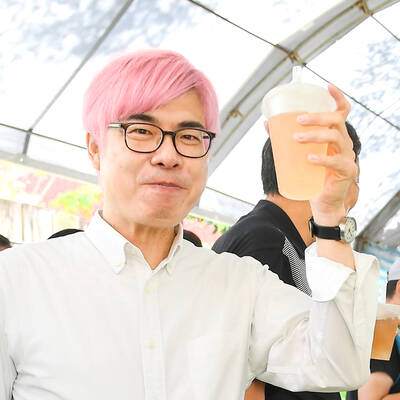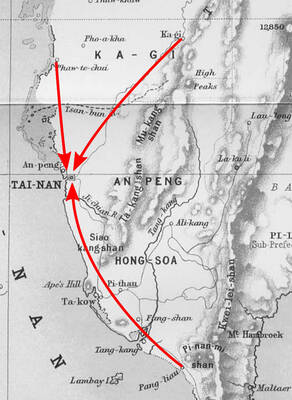Taiwan International Ethnographic Film Festival (TIEFF, 2009台灣國際民族誌影展) curator Lin Wen-ling (林文玲) drew on her experience of illness to settle on the themes of this year’s edition: the body, disease and healing.
“Being ill changes the way one senses and perceives the world,” Lin said. “The dominant Western medial system is by no means the only model to care for the body. Different cultures have developed different ideas ... regarding the body, mind and soul.”
People Say I’m Crazy examines how schizophrenia is treated and understood in the US. The film’s director, John Cadigan, and his sister, who co-directed, will attend a question-and-answer session after tomorrow’s screening.
Taiwanese filmmaker Yang Jen-tso (楊仁佐) studied Hansen’s disease for 10 years, which resulted in the documentary Leprous Life (時間的牢籠).
Leprous Life complements Lady Camellia, a South Korean documentary about a former Hansen’s disease sufferer who, aged four, was quarantined on Sorok Island.
Shamanism takes center stage in several documentaries that fix the lens on traditional beliefs and practices linking the spiritual and corporal worlds.
Living With the Invisibles follows a group of Moroccan women who believe they are being targeted by malevolent spirits and practice rituals to rid themselves of the perceived affliction.
In The Shadow, Wana shamans from Sulawesi, Indonesia, diagnose diseases by observing patients’ shadows and cure them by insufflation.
Films made by Aboriginal directors about their own communities have become the focal point of the biennial festival, which aims to change the conventional perception of ethnographic filmmaking that consists of outsiders making documentaries on exotic groups.
Bilin Yabu of Taiwan’s Atayal (泰雅) tribe, this year’s featured Aboriginal filmmaker, has made documentaries about his community’s culture for more than 10 years. His The Stories of Rainbow (彩虹的故事) is an insightful study on the disappearing tradition of facial tattooing, which is closely related to the Atayal understanding of life, death and the universe.
In Men’s Ocean, Women’s Calla Lily Field (男人的海洋,女人的水芋田), director and Tao (達悟) tribe member Hsieh Fu-mei (謝福美) documents the boat-building tradition that is practiced by the men of her community on Orchid Island (蘭嶼).
Also on the lineup of 34 films, which will be screened over five days are Norwegian Sami director Ellen-Astri Lundby’s Suddenly Sami, which follows the filmmaker’s search for identity; The Captive (被俘虜的人生) by Chen Hsin-yi (陳心怡), which tells the unusual story of her father, who was a Communist soldier taken captive by the Chinese Nationalist Army (KMT) and brought to Taiwan but remained silent about his true identity until his offspring turned the camera on him.
An international forum titled Just How Close Can a Filmmaker Get? will be held today from 2pm to 5pm at Spot — Taipei Film House (光點—台北之家), 18, Zhongshan N Road Sec 2, Taipei City
(台北市中山北路二段18號).
For more information, visit the festival’s bilingual site at www.tieff.sinica.edu.tw.

The Taipei Times last week reported that the rising share of seniors in the population is reshaping the nation’s housing markets. According to data from the Ministry of the Interior, about 850,000 residences were occupied by elderly people in the first quarter, including 655,000 that housed only one resident. H&B Realty chief researcher Jessica Hsu (徐佳馨), quoted in the article, said that there is rising demand for elderly-friendly housing, including units with elevators, barrier-free layouts and proximity to healthcare services. Hsu and others cited in the article highlighted the changing family residential dynamics, as children no longer live with parents,

It is jarring how differently Taiwan’s politics is portrayed in the international press compared to the local Chinese-language press. Viewed from abroad, Taiwan is seen as a geopolitical hotspot, or “The Most Dangerous Place on Earth,” as the Economist once blazoned across their cover. Meanwhile, tasked with facing down those existential threats, Taiwan’s leaders are dying their hair pink. These include former president Tsai Ing-wen (蔡英文), Vice President Hsiao Bi-khim (蕭美琴) and Kaohsiung Mayor Chen Chi-mai (陳其邁), among others. They are demonstrating what big fans they are of South Korean K-pop sensations Blackpink ahead of their concerts this weekend in Kaohsiung.

Taiwan is one of the world’s greatest per-capita consumers of seafood. Whereas the average human is thought to eat around 20kg of seafood per year, each Taiwanese gets through 27kg to 35kg of ocean delicacies annually, depending on which source you find most credible. Given the ubiquity of dishes like oyster omelet (蚵仔煎) and milkfish soup (虱目魚湯), the higher estimate may well be correct. By global standards, let alone local consumption patterns, I’m not much of a seafood fan. It’s not just a matter of taste, although that’s part of it. What I’ve read about the environmental impact of the

Oct 20 to Oct 26 After a day of fighting, the Japanese Army’s Second Division was resting when a curious delegation of two Scotsmen and 19 Taiwanese approached their camp. It was Oct. 20, 1895, and the troops had reached Taiye Village (太爺庄) in today’s Hunei District (湖內), Kaohsiung, just 10km away from their final target of Tainan. Led by Presbyterian missionaries Thomas Barclay and Duncan Ferguson, the group informed the Japanese that resistance leader Liu Yung-fu (劉永福) had fled to China the previous night, leaving his Black Flag Army fighters behind and the city in chaos. On behalf of the